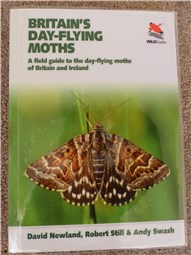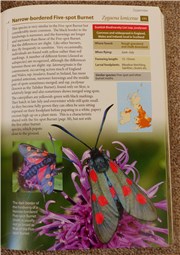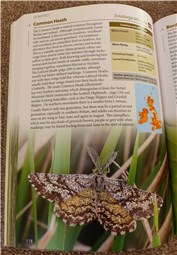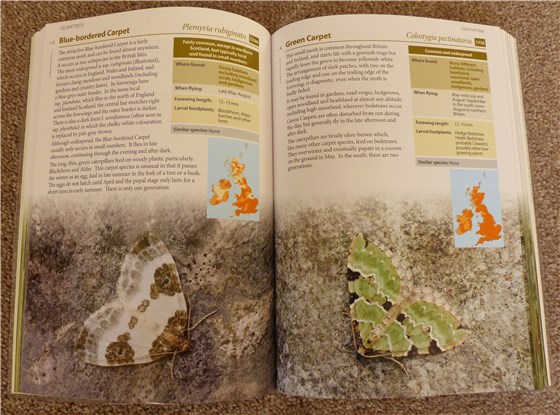Britains Day Flying Moths
Britain’s Day-flying Moths
A field guide to the day-flying moths of Britain and Ireland
By David Newland, Robert Still and Andy Swash
A WildGuide published by Princeton University Press
ISBN 978-0-691-15832-7

The eye-catching cover of Britain's Day-flying Moths
Now, it’s time for a confession: we’ve not really paid much attention before to moths and had pretty much written them off as only being drab and uninteresting insects. In fact, to many birdwatchers, taking up an interest in moths is like going over to the dark side. But thanks to this wonderful book, we have now seen the light! Some of our British day-flying moths are very attractive indeed to look at. These colourful characters can be found all across the country; in fact we’re likely to encounter them when we’re out and about on our regular birdwatching trips so we’re now looking around us with fresh eyes to see what moths as well as what birds we may find.
Some of our British day-flying moths are brightly coloured and would give our butterflies a real run for their money. Take the Grass Emerald and its rare cousin, the Small Grass Emerald, for example which starts life a glorious bluish-green colour and fades to grey as it ages. Seeing one of these handsome green chaps resting on the visitor centre at Sculthorpe Moor Community Nature Reserve was a really exciting moment for us moth-novices.
Or how about the Purple-bordered Gold, a real little jewel as its name suggest. This is a scarce moth but does occur in East Anglia and the northern Welsh Borders, so we’ll be keeping our eyes open next June and July when we’re out birdwatching in case we catch a glimpse of a gem in flight.
And then there’s the Burnet family which come in a variety of shapes and sizes and with varying numbers of spots and marks on their wings, but all in an amazing colour scheme of black and vermilion, the red flashing like the lining of Dracula’s cape as they fly about!

The jazzy Narrow-bordered Five-spot Burnet
Others may be more subtle in colour but feature intricate designs, such as the Argent and Sable moth which looks as though it is covered in black-and-white leopard spots. Or even the Common Heath which may be as common as its name suggests but has such delicately-patterned wings in gentle hues of grey to brown to yellow that it definitely bears closer inspection. And if the colours don’t appeal to you, then how about the names? Any field guide that combines tussocks, footmen, tigers, carpets and lace borders has got to be worth studying!

The Common Heath - well worth a closer look!
So why have we been converted to the moth appreciation society? Well apart from the wonderful cast of the moths themselves, this handy-sized field guide has so many star features. It starts with the robust plastic cover to protect the book as you take it out and about with you. Why don’t more field guides have this? We know from experience how being bounced around in a rucksack and handled a lot in the field can quickly make even a new book worn and tatty.
Open the book and you start with some very interesting background information, for example an explanation of what is a day-flying moth. Not quite as self-explanatory as you might think: how do you classify a night-flier who is disturbed into flying about in the daytime? This is followed by other useful information such as their taxonomic naming, what key identification features to look for to identify the family, what habitats suit which kind of moth and what plants provide the main food for which caterpillar species.
Turn more pages and you get into the main species accounts and here is probably the real star feature of this book. Each moth is dealt with individually in detail, with a complete page per species and all with the same clear and attractive layout. Firstly there’s a fantastic full-colour photograph of the moth covering half the page. These fantastic illustrations really draw you into the page and make you want to learn more. The other half of each page includes a descriptive passage about the species about where and when to look for it and any particular identification features or habits of both the caterpillars and the adult moth. This is easy to read and appealing to layman and is supplemented by a table of key facts and each moth’s vital statistics: national status, habitat, which month to look for it, forewing length, its larval foodplant, and any similar or confusion species.

Blue-bordered Carpet, Green Carpet and beige carpet!
At the back of the book there’s a handy summary check so you can quickly see all the key information for each moth featured, a good way of shortlisting which moth you may have just seen flying by if you’re a little unsure of your moth ID. There’s information about moth conservation and the status of species, and if you’d like to get more involved or just to learn more about these fascinating insects, there are plenty of useful contacts and websites to check out. And the helpful information continues right up to the inside back cover as the book ends with a ruler and size comparison illustrations to help you keep a sense of scale and separate your macro- from your micro-moths!
With its ideal mix of superb photography, approachable information and factual detail we are sure this WildGuide by Princeton University Press will make the perfect companion for anybody looking at day-flying moths, whether they are an absolute beginner or dedicated enthusiast. We have been totally converted to the appeal of day-flying moths, and if our own experience is anything to go by, we’d advise you to forget your moth preconceptions, pick up this book and start enjoying those moths – there’s a lot more to them than meets the eye.
Review by Ruth Miller and Alan Davies
The Biggest Twitch Ltd
www.thebiggesttwitch.com
November 2013
If you have a wildlife book you would like us to review, please contact us on
info@thebiggesttwitch.com.